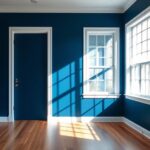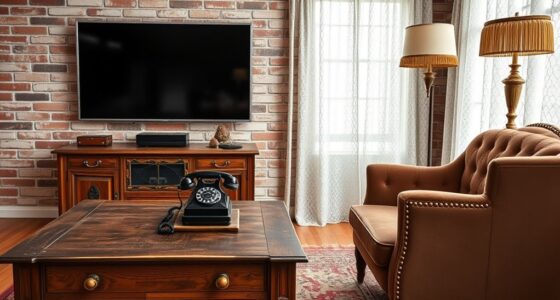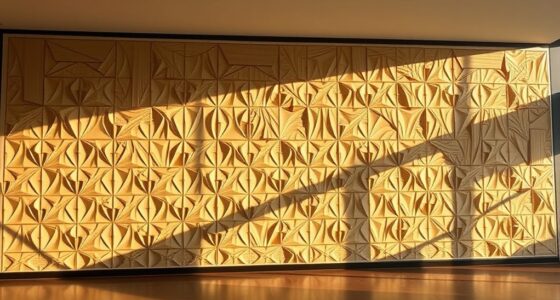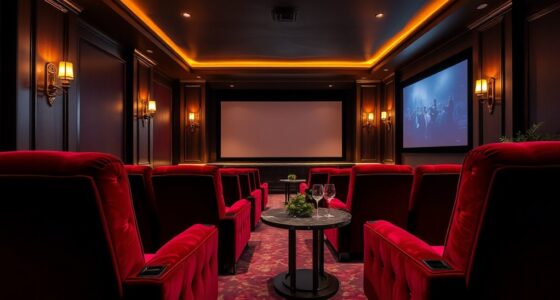To improve contrast on your walls, opt for bold, contrasting color pairs like deep navy with crisp white or vibrant red with subtle beige. Use finishes like semi-gloss or high-gloss to reflect light and emphasize differences, while matte surfaces soften contrasts for a more subdued look. Play with hues that highlight architectural features and create depth in your space. Keep exploring to discover more expert tips on choosing perfect combinations for striking, cohesive interiors.
Key Takeaways
- Use contrasting shades close in hue, like navy blue with white, for vibrant visual separation.
- Incorporate glossy or semi-gloss finishes on trims and moldings to enhance contrast with matte walls.
- Pair bold, bright colors such as red or green with neutral backgrounds to create striking focal points.
- Select deep, dark hues alongside lighter shades to add depth and dimension to walls.
- Combine color contrasts with textured finishes to amplify visual interest and highlight architectural features.
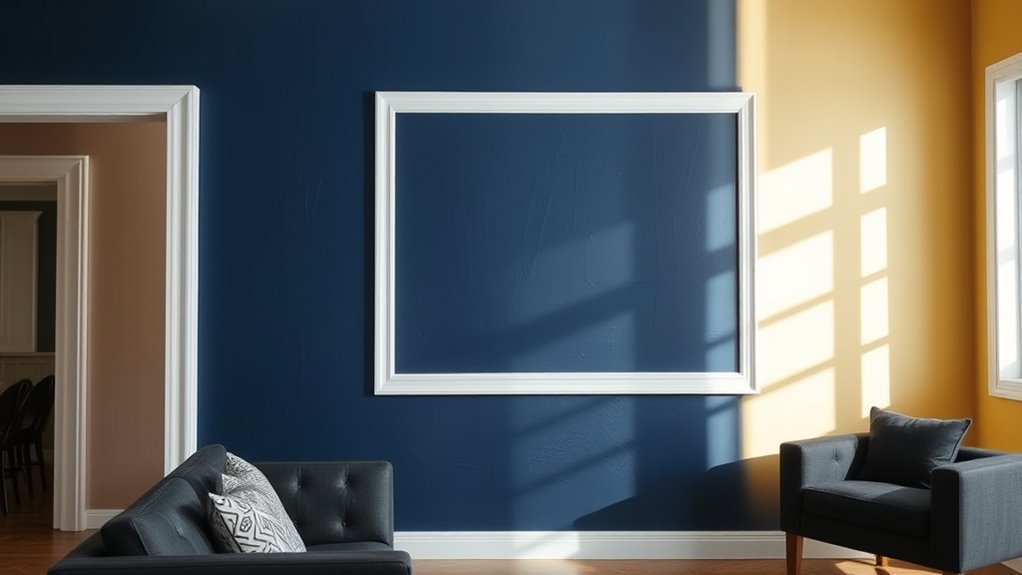
Ever wondered how wall paint colors can transform the mood and style of a room? The right choice of colors can dramatically enhance contrast, making your space more engaging and visually appealing. When aiming for improved contrast, your first consideration should be the color palette options you select. Opt for contrasting shades that are close enough to complement each other but different enough to create a distinct separation. For example, pairing a deep navy blue with crisp white can make both colors pop, adding depth and vibrancy to your space. Bright, bold hues like red and green or plum and beige also work well to create striking contrast without overwhelming the eye. By choosing a variety of hues within your color palette options, you can establish a dynamic environment that draws attention to specific areas or features.
Beyond just selecting the right colors, you also need to think about finish textures. The finish of your wall paint plays a vital role in how contrast is perceived. Matte or flat finishes tend to absorb light, giving a softer, subtler contrast that works well in creating a cozy, understated look. Conversely, satin, semi-gloss, or high-gloss finishes reflect more light, amplifying the contrast between different colors and making details stand out more sharply. For instance, painting moldings or trims in a semi-gloss finish against a matte wall can heighten the visual distinction, emphasizing architectural features. Texture can be a powerful tool, allowing you to manipulate how light interacts with your walls and thereby intensify or soften contrast, depending on your desired effect. Additionally, understanding the visual impact of contrasting colors can help you make more informed choices that enhance your room’s aesthetic.
When choosing your wall paint colors for contrast, keep in mind the overall style and purpose of your room. If you want a lively, energetic vibe, go for vibrant hues paired with shiny finishes. For a more subdued, elegant look, stick with muted shades and matte textures. Remember, contrast isn’t just about color; it’s about how those colors interact with their finish textures and the lighting in your space. Properly combining contrasting colors with the right finish textures can make your walls appear more dimensional and lively, adding visual interest and sophistication. Whether you’re highlighting a feature wall or creating a balanced, harmonious environment, the strategic use of color palette options and finish textures will help you achieve a stunning, contrasting look that elevates your room’s aesthetic.
Frequently Asked Questions
How Do Wall Colors Affect Room Lighting and Ambiance?
You’ll notice that wall colors considerably affect your room’s lighting effects and ambiance. Bright, light hues reflect more light, making your space feel airy and open, while darker shades absorb light, creating a cozy, intimate atmosphere. By understanding color psychology, you can choose colors that evoke the mood you want, whether calming blues or energizing reds. Your choice of wall paint shapes how light interacts and how you feel in the room.
What Colors Are Best for Small or Dark Rooms?
If you want to brighten small or dark rooms, go for light, reflective colors like soft whites, pale grays, or warm beiges. These colors enhance natural light and make the space feel larger. Pair them with subtle textures to add depth without overwhelming. Consider color pairing with gentle contrasts to keep the room lively but not cluttered. Texture enhancement also helps create visual interest while maintaining a spacious and airy feel.
Can Contrast Paint Colors Improve Room Acoustics?
Contrast paint colors can slightly influence room acoustics by affecting sound reflection and absorption. Darker or matte finishes tend to absorb more sound, reducing echo and improving acoustics, while lighter or glossy paints reflect sound, possibly increasing noise levels. To enhance acoustic absorption, choose paint colors with matte textures and darker shades, which help minimize sound reflection and create a more comfortable, acoustically balanced space.
How Do Wall Colors Influence Mood and Productivity?
You’ll notice that wall colors directly influence your mood and productivity through color psychology. For example, a home office painted in calming blue promotes focus and reduces stress. When you choose colors that create color harmony, your space feels balanced and inviting, boosting your motivation. By thoughtfully selecting wall colors, you can craft an environment that enhances your mental clarity and overall well-being, making every task more enjoyable.
Are There Seasonal or Trend-Based Color Preferences?
You’ll notice seasonal color shifts influence your preferences, as brighter hues often energize you in winter, while softer tones soothe you in summer. Trending paint palettes change with design trends, so staying updated helps you select modern, appealing colors. To keep your space fresh, consider incorporating trending shades that align with the season’s vibe. This approach guarantees your environment feels current, lively, and tailored to your mood year-round.
Conclusion
Choosing the right wall paint colors can truly transform your space and enhance contrast effortlessly. Remember, a house is made of walls, but it’s the colors you choose that give it soul. Don’t be afraid to experiment and trust your instincts—after all, beauty lies in the eye of the beholder. As the saying goes, “Change your walls, change your world.” So, go ahead, create a vibrant and balanced environment you’ll love coming home to.



